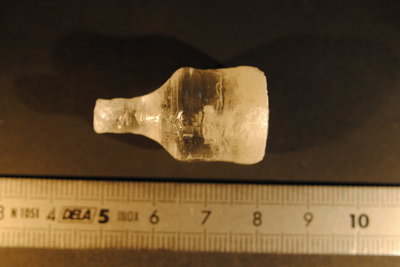| Search for content and authors |
A promising nonlinear crystal for third harmonic generation in UV: Ca5(BO3)3F |
| Simon Ilas 1, Loïc Deyra 2, Alexandra Szemjonov 1, Pascal Loiseau 1, Gérard Aka 1, François Balembois 2, Patrick Georges 2, François Salin 3 |
|
1. Ecole Nationale Supérieure de chimie de Paris (ENSCP), 11 rue P. et M. Curie, Paris 75005, France |
| Abstract |
|
CBF is a potential nonlinear material for third harmonic generation. CBF single crystals were grown using LiF as a flux. 300 mW average power at 343 nm by frequency tripling were obtained. deff were estimated as from conversion efficiency measurements. We present here studies of new flux to growth CBF such as: LiF-B2O3, LiF-NaF, LiF-CaF2, CaF2, NaF. Diffferentiel thermal analysis (DTA), spontaneous crystallization and crystal growth using these flux will be presented.
The calcium fluoroborate, Ca5(BO3)3F is an interesting and new nonlinear optical material for UV applications. This material crystallizes in the same acentric space group Cm (Z=2) as YCa4O(BO3)3 (YCOB) but with extented properties towards UV. CBF can be grown by flux method, using LiF as a flux [1][2]. Its structure is built from [BO3]3- anionic groups, which are the most suitable for the design of nonlinear crystals aimed to have UV applications. CBF can be considered as derived from YCOB since Y3+ is replaced by Ca2+ and O2- is substituted by F- to preserve the electroneutrality of its structure. The CBF crystals are chemically stable and are not hygroscopic. The UV absorption edge of CBF is around 190nm. The nonlinear optical properties was determined by Xu et al [3]. 2. Third harmonic generation in CBF (λ=343 nm) A CBF crystal with a large size (diameter = 17 mm and length = 35 mm) has been obtained by using 20wt% LiF as flux in air (Fig. 1). The CBF boule was cut in two different planes corresponding to the two possible type-II THG phase matching directions for 1030 nm: two crystals of dimensions 3x3x3 mm3 were cut in the YZ plane, with θ=57.7° and a third crystal of dimension 3x3x5 mm3 was cut in the XY plane with φ=72.6°. We used for the experiment an infrared source emitting 20 W at 1030 nm at a repetition rate of 30 kHz with pulse width of 15 ns. A 20 mm long, type-I LBO was used in NCPM configuration to obtain 12 W of green power. Both XY and YZ principal planes of the type II-CBF crystals were tested and the UV output power was measured. 300 mW average power was obtained in the XY plane and 130 mW average power in the YZ plane. deff were estimated as from conversion efficiency measurements: 0,48 pm/V in the XY plane and 0,35 pm/V in the YZ plane.
Fig. 1: CBF single crystal grown using LiF as a flux 3. Study of new flux The usual flux to growth CBF is LiF. The prominent drawback of LiF is its volatility. Moreover, single crystals of CBF often contain inclusions of LiF. That is why an optimization of the flux has to be done. We have studied the influence of LiF-B2O3, LiF-NaF, LiF-CaF2, CaF2, NaF on thermal properties and growth of CBF. The crystallization temperature of CBF for the ratio 20 CBF / 80 LiF (% mol) is around 1000 °C. We studied the system 20 CBF - (80 - x) LiF - x B2O3. The addition of B2O3 to LiF allows to reduce the crystallization temperature of CBF to 950 °C for the composition 20 CBF - 75 LiF - 5 B2O3. This is interesting concerning the volatility of the melt. With NaF as a flux, CBF crystallize at 1000 °C too but X-ray diffraction analysis reveals Ca3B2O6 phase. The ratio CBF/NaF has to be adjusted to see if NaF can be a suitable flux for CBF. The DTA study of the system 20 CBF – (80-x) LiF – x CaF2 (% mol) is represented on Figure 2.
Fig. 2: differential thermal analysis cooling curves of the system 20 CBF - (80-x) LiF - x CaF2 The use of CaF2 is interesting because the thermal properties of the system are not changed while reducing the quantity of LiF. The other advantage is that CaF2 is one of the reagent in the synthesis of CBF so it does not disturb the system by introducing foreign elements. Spontaneous crystallization and growth of single crystals using flux mentioned above will be presented at the conference. [1]G. Chen et al, Journal of Crystal Growth, 292, 449–453 (2006). [2]Xu et al, Crystal Growth & Design, 9, 2235-2239 (2009) [3]Xu et al, Optics Express, 16, (2008) |
| Legal notice |
|
| Related papers |
Presentation: Oral at 17th International Conference on Crystal Growth and Epitaxy - ICCGE-17, Topical Session 6, by Pascal LoiseauSee On-line Journal of 17th International Conference on Crystal Growth and Epitaxy - ICCGE-17 Submitted: 2013-04-12 15:03 Revised: 2013-07-23 18:09 |